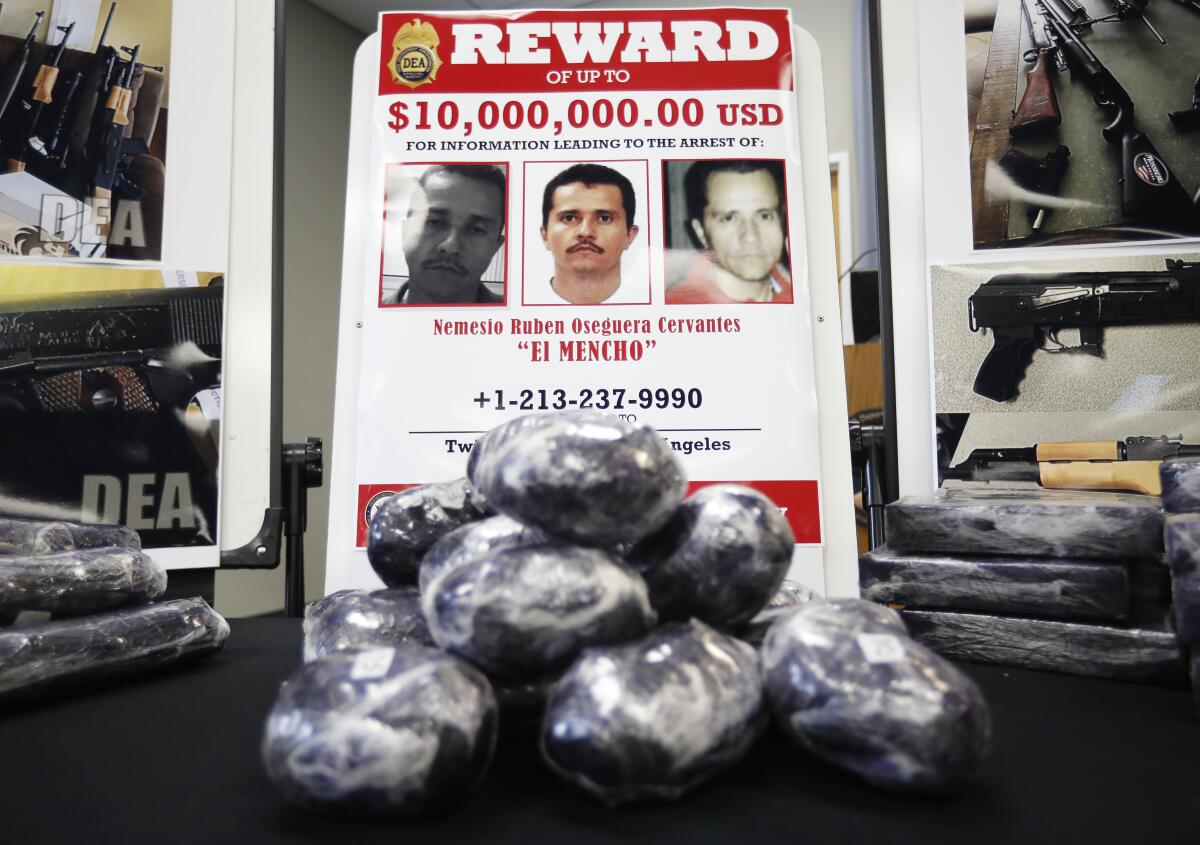San Diego quietly prosecuting high-ranking members of ultra-violent Cártel Jalisco Nueva Generación

A San Diego federal judge recently sentenced two associates of Nemesio “El Mencho” Oseguera Cervantes, leader of CJNG, a newly dominant force in Tijuana.
- Share via
SAN DIEGO — For the better part of a decade, federal prosecutions of Mexican drug cartel leaders carried out in San Diego have focused largely on the Sinaloa Cartel, and before that the Arellano Félix Organization, the two groups that have historically dominated the lucrative Tijuana-San Diego smuggling route.
But last month, a federal judge sentenced two former high-ranking members of the Cártel Jalisco Nueva Generación, part of an ongoing prosecution against at least 12 people charged with drug trafficking and money laundering crimes. The case may be one of the first local prosecutions to target prominent members of the CJNG, one of Mexico’s most ruthless cartels that has grown in influence over the last dozen or so years.
Prosecutors have played the case close to the vest, keeping most details out of public court records. And while the indictment deals with criminal conduct carried out several years ago, the prosecution reflects the CJNG’s continued rise to power, both across Mexico and specifically in Baja California.
“My guess is there have been some prosecutions (of top CJNG leaders) ... but (authorities) are keeping the cases more low profile,” said Laura Calderón, program director for the University of San Diego’s Justice in Mexico project. “They know how volatile ‘El Mencho’ is, how extreme his measures of violence are.”
El Mencho is CJNG leader Nemesio Oseguera Cervantes, one of the most-wanted drug lords in the world and the subject of a $10 million bounty from the U.S. Drug Enforcement Administration. According to a Justice in Mexico report, since about 2012 he’s been the top leader of the cartel that years earlier broke away from the Sinaloa Cartel of Joaquín “El Chapo” Guzmán and Ismael “El Mayo” Zambada.
“This could be an increasing trend,” Calderón said of the targeting of top CJNG members. “The (CJNG) was kind of underrated for a while. No one thought they would overcome Sinaloa. And while everyone was focused on getting Chapo and Mayo, (few were) paying attention to them.”
The two CJNG leaders sentenced last month were Víctor Zapién Venegas, alias “Domingo,” and Juan Padilla Vizcarra, known as “El Cherri” or “El Cherry.”
Media reports at the time of his extradition had described Zapién as a “close collaborator” of El Mencho. Padilla was described in Mexican media reports as one of El Mencho’s lieutenants.
They were prosecuted as part of a 2016 indictment that charged at least a dozen people with drug trafficking and money laundering. So far, only Zapién, Padilla and two other defendants have been identified, while the other eight or so names from the indictment — including those of the top four defendants — have remained sealed.
A federal grand jury handed down that indictment around the same time the CJNG was expanding into Baja California, fueling a wave of violence and murders. USD’s Calderón said the CJNG, which pioneered the trafficking of synthetic drugs such as methamphetamine and fentanyl, “likes to brag, to take credit and to broadcast its violence.”
Not only do the group’s members hang bodies from bridges, scatter severed heads in public places and leave written signs taking ownership of murders and attacks, they also livestream deadly clashes with government forces or rival cartels.
“They’re proud of the violence they use,” Calderón said. “They just love showcasing what they can do.”
The bravado helps them rule by fear and intimidation. Calderón said CJNG soldiers have filmed themselves driving military-style armored vehicles into towns previously controlled by rival groups and claiming them as their own.
“They’re saying ‘We’re here, now you know who’s the boss, respect us because El Mencho’s here,’” Calderón said.
The group is suspected of being behind attacks this summer involving dozens of burning vehicles that essentially shut down Tijuana and several other Mexican cities over the course of several days.
The group made international headlines again this week when Mexican soldiers and federal agents captured El Mencho’s older brother, Antonio Oseguera Cervantes, alias “Tony Montana.” One part of his responsibilities was allegedly manufacturing the group’s armored vehicles.
That arrest in Jalisco was unrelated to the recent sentencings here of Zapién and Padilla, according to Zapién’s attorney.
In court filings, Assistant U.S. Attorney Kyle Martin recommended seven-year terms, which were several years less than what federal sentencing guidelines suggested.
“I believe my client was treated fairly by the court, he accepted responsibility for what he did, and he at no point did, or will ever, cooperate,” Zapién attorney Jason Conforti said.
Padilla’s attorney declined to comment.
The prosecution of high-ranking CJNG members in San Diego federal court has appeared relatively rare, though there have been some exceptions. In 2018, the Department of Justice announced 15 indictments nationwide aimed at taking down CJNG leaders, including one case unsealed that day in the Southern District of California. It was a two-count drug conspiracy indictment charging Juan José Pérez Vargas, known as “El Piolín,” who was believed to be the leader of CJNG’s operations in Tijuana.
Pérez Vargas was described in Mexican news reports as a former Sinaloa Cartel operative born in San Diego. At the time, he was in Mexican custody following his 2017 capture in Guadalajara. He was expected to be extradited to San Diego, but he died in May 2019 under unclear circumstances in a Mexican prison.
An indictment unsealed last year pinned a wave of murders in Tijuana on a criminal cell known as Los Cabos, who allegedly acted as a violent enforcement arm of the CJNG as the group battled the Sinaloa Cartel for control of the Tijuana-San Diego smuggling corridor.
The U.S. Attorney’s Office has kept the prosecution against Zapién, Padilla and their unnamed co-defendants mostly under wraps and did not respond to multiple requests for comment. And neither the government nor defense attorneys for Zapién or Padilla filed sentencing memorandums that typically spell out the details of the criminal conduct.
That has left much of the case still shrouded in mystery. Court records show a judge issued arrest warrants for both men in March 2016. Authorities arrested Padilla sometime that same year, according to Mexican media reports. Zapién was arrested in September 2016 in Playas del Rosarito in Baja California. Both were extradited to San Diego within the last two years.
According to the initial indictment, both men were part of a conspiracy to traffic cocaine, heroin, cannabis and methamphetamine into the U.S., and both were also part of a conspiracy to launder the drug proceeds. Both ultimately pleaded guilty to one count each for a cocaine-trafficking conspiracy.
Zapién admitted in his plea agreement to coordinating at least three shipments of cocaine into the U.S. in 2014. Padilla admitted to at least four separate incidents in 2014 and 2015 in which he coordinated cocaine shipments into the U.S.
Both men admitted the shipments of cocaine they coordinated totaled more than 330 pounds but less than 990 pounds.
Another defendant named in the indictment, Hugo Rosalio Lugo Inda, alias “Wero,” pleaded guilty in 2018 to a money-laundering charge, admitting the cash value of the drug proceeds he laundered between 2014 and 2016 exceeded $1.5 million. He was sentenced to two years and four months in prison.
His attorney wrote in a brief sentencing memorandum that Lugo had been running the financial side of several businesses when, through his children’s school, he met and started doing business with several men who “eventually ... had Mr. Lugo laundering drug money for them.” The attorney wrote that it was the first time his then-44-year-old client had been in trouble with the law, and that “Lugo withdrew from the illegal activity over a year before his arrest.”
In October, a fourth defendant was arrested in Texas — or possibly extradited there from Mexico — and then transferred last month to San Diego, where he pleaded not guilty to a trafficking count from the indictment.
More to Read
Sign up for Essential California
The most important California stories and recommendations in your inbox every morning.
You may occasionally receive promotional content from the Los Angeles Times.











